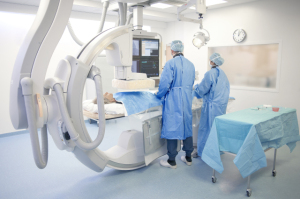by
Carol Ko, Staff Writer | July 15, 2013

Philips' new live image guidance system,
AlluraClarity.
Royal Philips has received 510(k) clearance from the U.S. Food and Drug Administration (FDA) for its AlluraClarity live image guidance system in the U.S., following its introduction in countries outside the U.S. in 2012.
The system, designed to provide live image guidance for the full spectrum of interventional procedures, addresses two big trends in the imaging world: dose reduction and the rapid rise of minimally invasive interventional procedures.
Physicians face more challenges now as minimally invasive procedures become longer and more complex, requiring better image quality. On the other hand, a growing number of obese and high risk patients are driving the demand for dose reduction.



Ad Statistics
Times Displayed: 174467
Times Visited: 3182 For those who need to move fast and expand clinical capabilities -- and would love new equipment -- the uCT 550 Advance offers a new fully configured 80-slice CT in up to 2 weeks with routine maintenance and parts and Software Upgrades for Life™ included.
"To really solve the issue we developed a brand new system. We evaluated the whole system and redesigned the system from the ground up," Gerard Slootweg, senior field marketing manager of interventional X-ray and electrophysiology at Philips, told DOTmed News.
Philips’ new interventional X-ray system employs Clarity IQ technology, proprietary software and hardware improvements that provide advanced image processing while reducing dose. Clarity IQ's components are designed to automatically kick in and engage depending on the clinical specialty.
"For example, if you're working in the brain it knows to apply pixel shift and image enhancement more because of the need to visualize smaller vessels or eliminate any image artifacts due to patient movement," said Stefka Koenig, senior director of marketing in interventional X-ray at Philips.
The machine also has a flexible digital imaging pipeline from tube to detector to display that can be tailored for different applications, ranging from cardiology to neurology to endovascular.
The new system also offers over 500 clinically fine-tuned parameters for each application, allowing for filtering out more X-ray radiation, using smaller focal spot sizes, as well as shorter pulses with the grid switching technology of the Philips MRC tube and accompanying generator. “We worked more than three years with leading physicians to tweak the parameters in a clinical setting," said Slootweg.
"What is the actual level of radiation that the patient is exposed to? Knowing the dose savings alone isn’t enough to determine how much dose the patient and staff are really getting. One has to look at what these dose savings are being compared to, what the baseline was to begin with,” said Koenig.
The company cites an independent study released by the American Association of Physicists, which they say graphically shows that a previous model of Philips' live image guidance system uses significantly less dose than every other major vendor.
Keeping in mind that budgets remain tight for U.S. hospitals, Philips will also be offering this new technology as an upgrade to help their customers extend the life of their machines. "We're happy that our new generation technology can be offered not to just new customers but our existing install-base as well," said Koenig.

